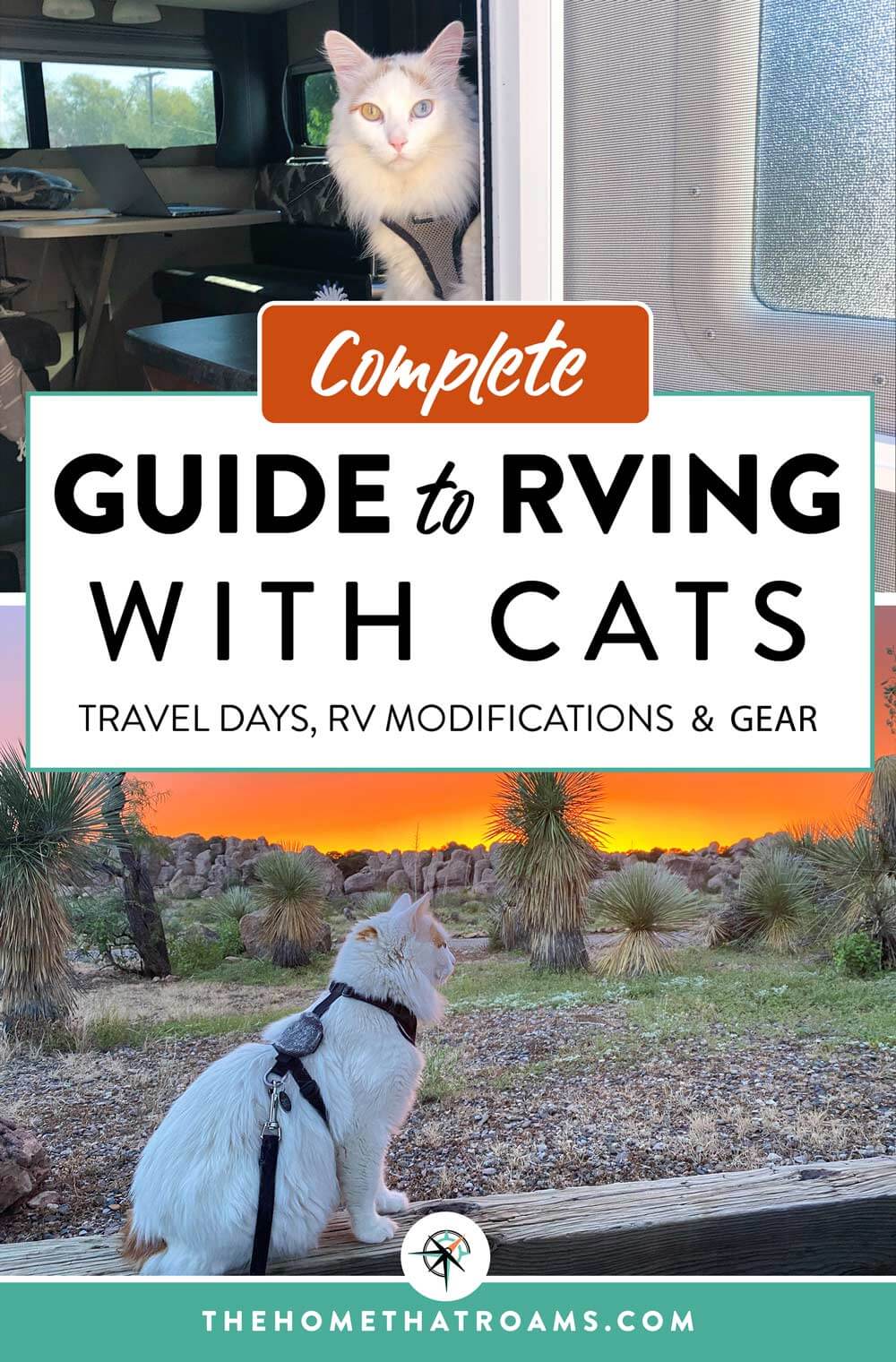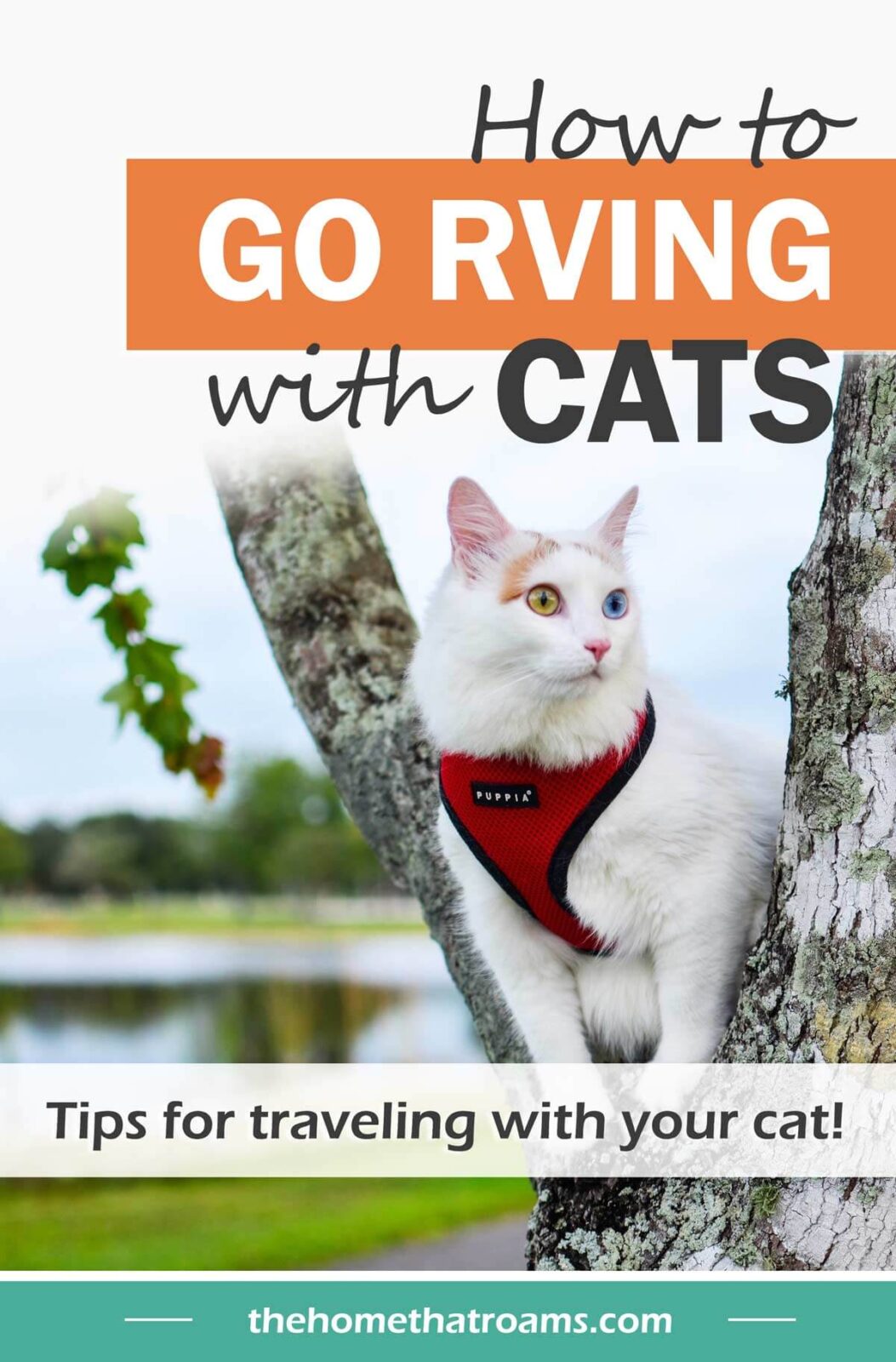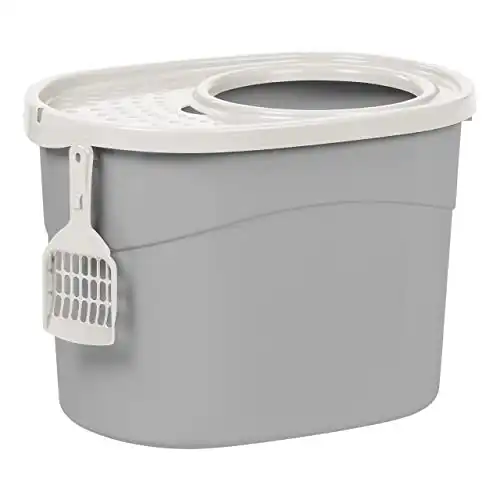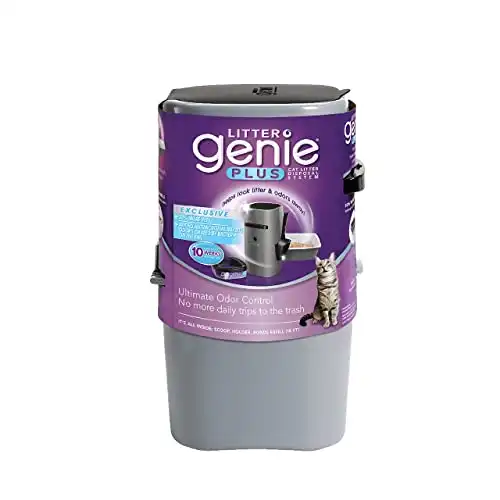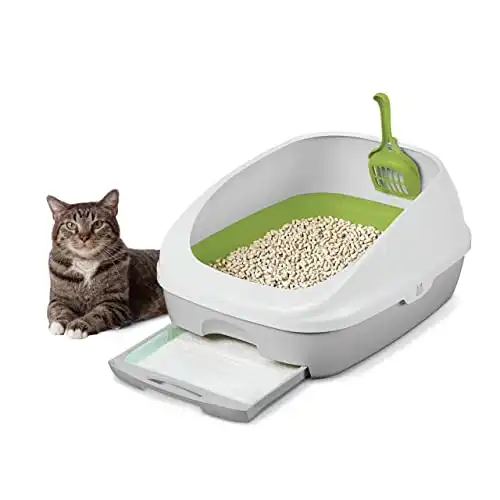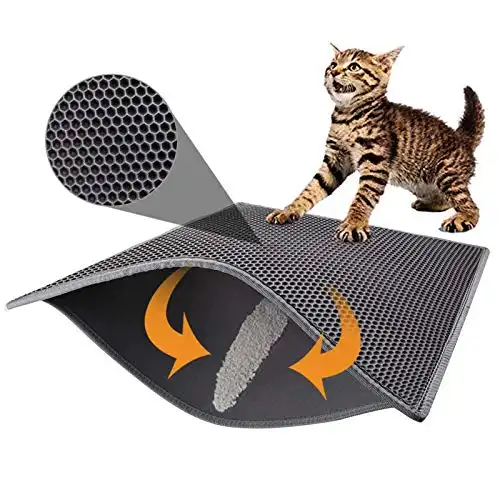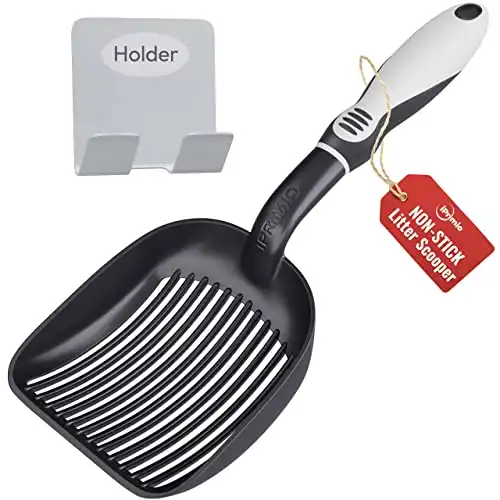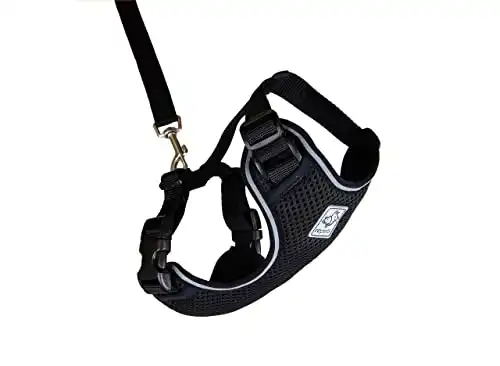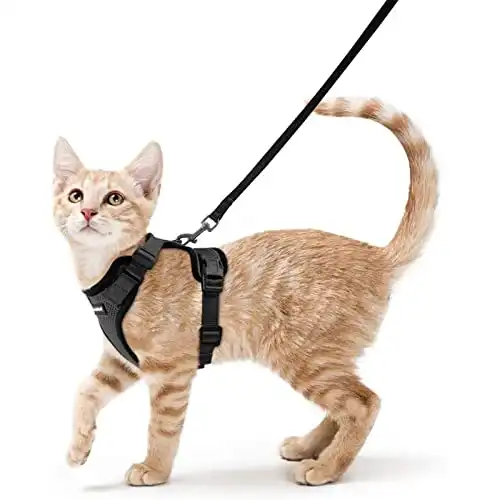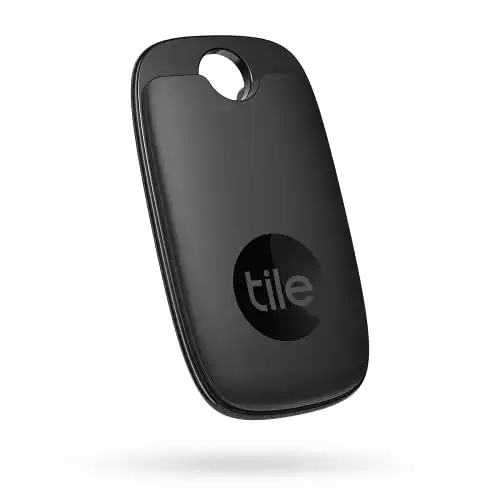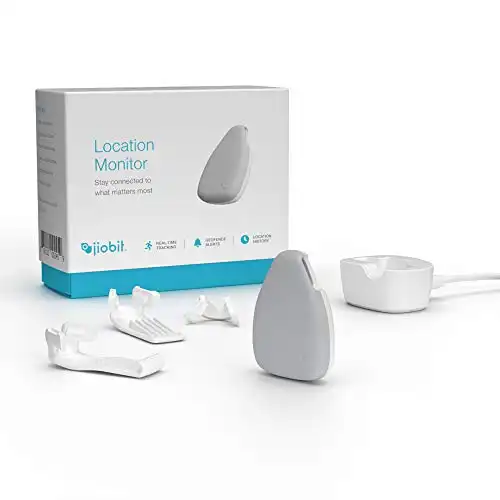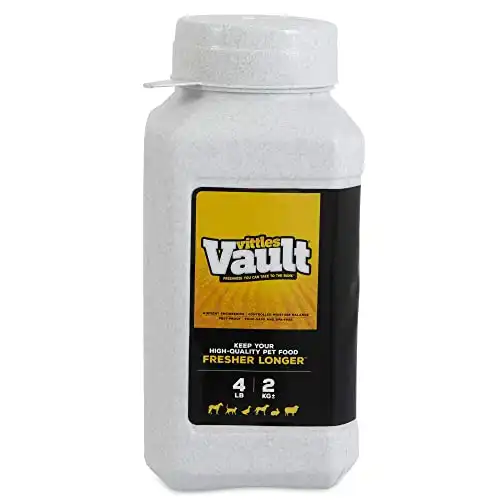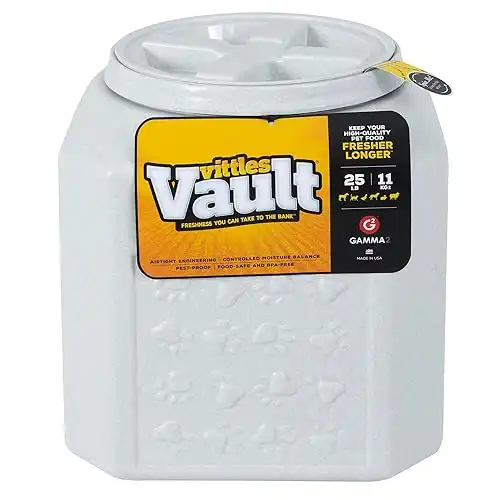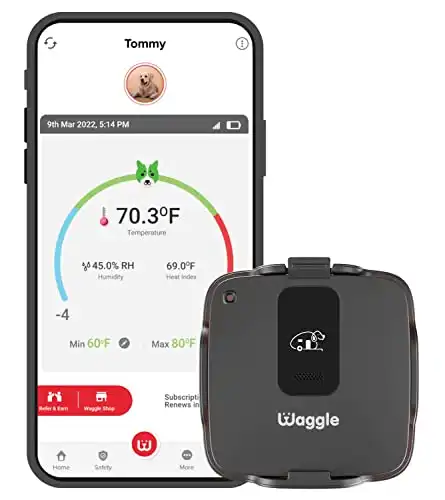How to Go RVing with Cats: A Complete Guide
As an Amazon Associate, we earn from qualifying purchases. We also earn from other affiliate websites. See our full disclaimer.
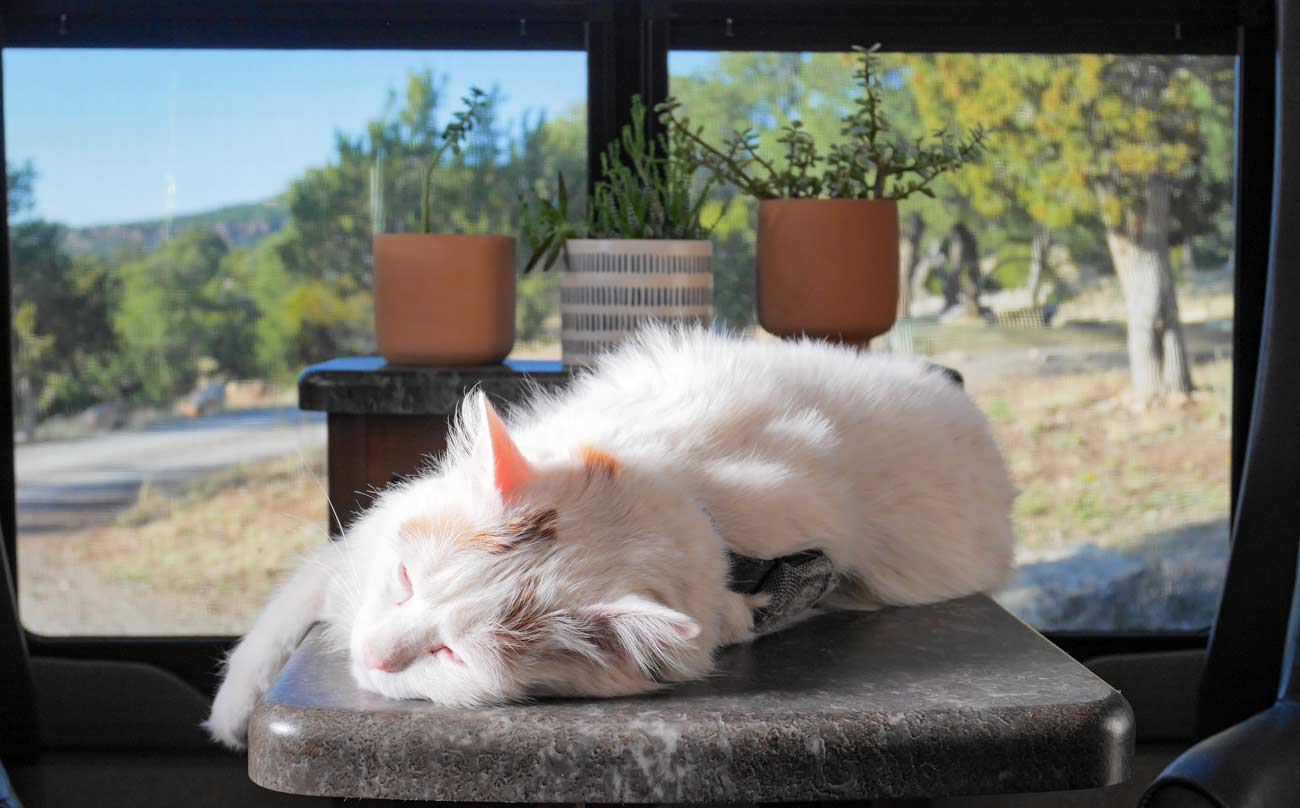
RVing with a cat can be a great way to travel with your feline companion. Cats are typically very adaptable creatures, and many enjoy being in new environments. RVing allows cats to explore the great outdoors while still enjoying the safety of their enclosed rolling home.
Can You Live in an RV with Cats?
The short answer is yes. RV living with pets is always challenging, and RVing with cats is no different. But it can be done with some extra planning and preparation. Below we’ll cover topics to consider if you are hitting the road with your feline friend. Specifically, we’ll cover topics to ensure your cat’s comfort and safety are not compromised. A happy cat makes a happy human!
Here is our complete guide to RVing with cats and living to tell the tale!
Choosing the Best RV for Your Cat
We have lived in a class C motorhome and a 23-foot travel trailer with our cat. If you are getting ready to buy an RV, here are a few things to consider when it comes to living in an RV with your cat.
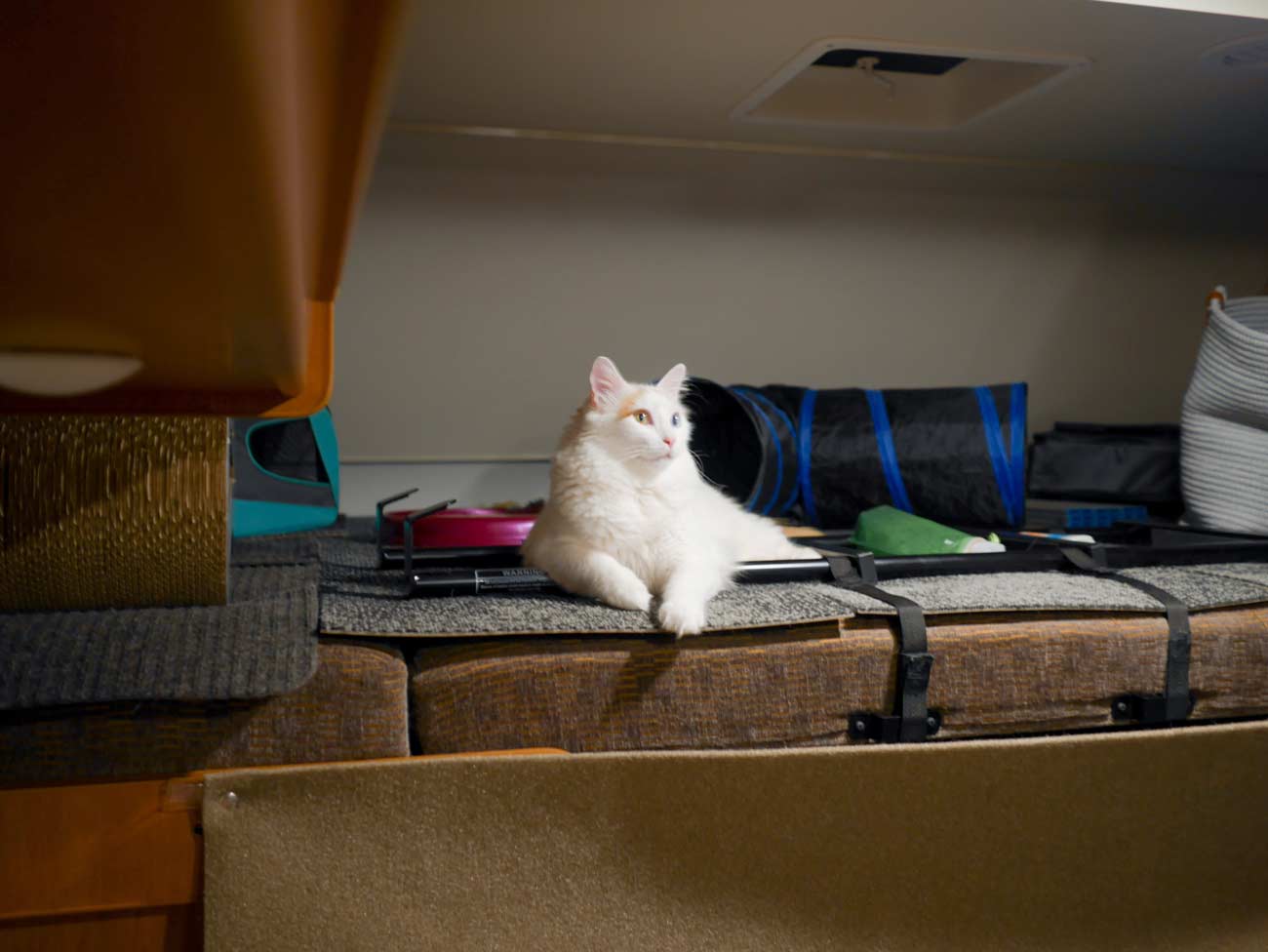
- GETTING READY TO TRAVEL. RV towables (travel trailers and fifth-wheels) will require your kitty to travel in the truck or SUV on travel days. This means more planning and effort to move your cat to the vehicle. When you travel in a motorhome, you can typically let your cat find a comfy spot to ride or put them in a carrier.
- REST STOPS AND BREAKS. It’s much easier to let your cat have a break on travel days when you are in a motorhome. You can park the motorhome at a rest stop, let your cat drink water, eat, and use the litter box. If you have a towable, you’ll either need to have these things available in the towing vehicle or move your cat to the RV, which can be more stressful on the cat.
- OVER CAB SPACE IN CLASS C MOTORHOMES. This area of the class Cs is a fantastic spot for a ‘kitty lair.’ Cats love being up high, so the cab overhang is a convenient built-in spot to put all the toys and cat scratchers and even make a comfy travel day space for your kitty.
- RUNNING ERRANDS. The ability to disconnect your RV from your vehicle is a plus for your cat. You’ll need to run errands with your cat if you travel in a motorhome but don’t have a toad (a car towed behind a motorhome). This situation can be problematic in areas with a hot climate, especially if you need an hour in the grocery store!
As you may have gathered, there are typically a lot of benefits to traveling with your cat in a motorhome. Depending on how often you travel and how well your cat travels, this may not significantly impact you.
Assess your camping style and decide what works best for your situation and your pet.
Do Cats Travel Well in RVs?
Some cats might take to the RV lifestyle immediately, but most will need time and space to adjust to living and traveling on the road.
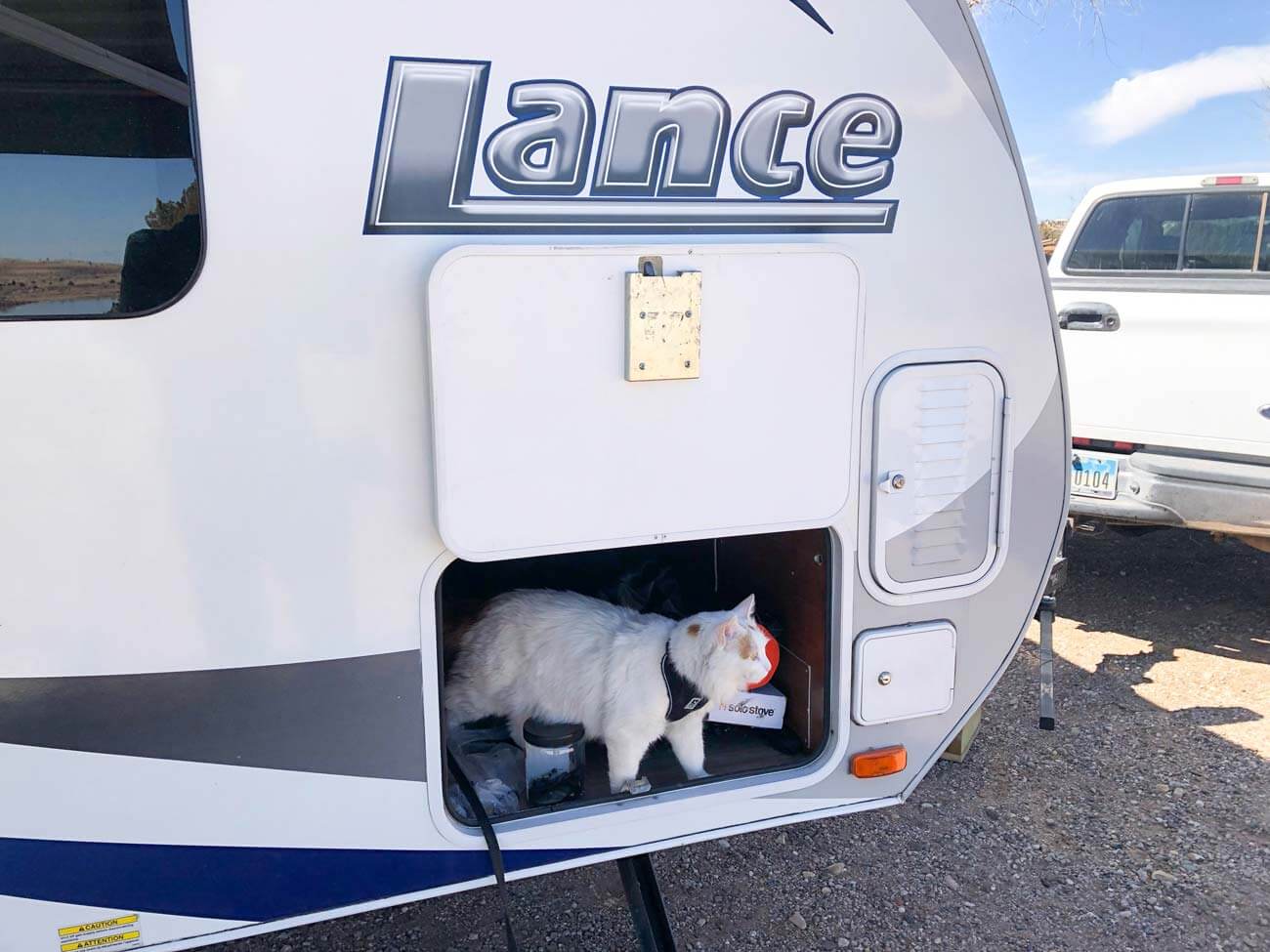
Here are a few tips to get your cat adjusted to RVing.
- Let them explore the RV for at least a week for a few hours at a time before they take a road trip.
- While they adjust to short visits in the RV, make sure they have food and water available, give them toys and treats as encouragement, and let them know where the litter box is located.
- If you have a towable RV, ensure your cat is familiar with riding in a car. Take short trips to see how they do. Most cats do better in a carrier, at least to start. We’ve found that putting a towel over the crate reduces stress.
- If you have a motorhome, decide how you will travel with your cat. Take a short drive and see if your cat finds a spot to settle in. Or you can put them in a carrier to ensure there are no issues.
- Once you’re on the road, keep an eye on your cat to ensure they’re adjusting well. If they seem stressed or anxious, take a break from driving to give them some attention. For overly anxious cats, you can try a calming spray on travel days.
- Embrace slow traveling with your cat and keep RV travel days short. Most cats can do three or four-hour travel days comfortably.
Once your cat understands the routine of RV life, there’s no reason they won’t do very well on the road.
Cats typically like the change of scenery and are interested in new places and smells. When they are accustomed to the RV as their home, they’ll enjoy traveling while having that familiarity, much like us humans do!
How to Keep Cats from Escaping RV
Cats are curious creatures, and they often want to thoroughly examine their surroundings. This trait can lead to challenges when you’re RVing with cats, as they may try to escape their home on wheels to get a better look around.
Some cats might try and sneak out the door when it opens, and others will sit on a shelf by the door and jump over you – we’ve even heard of some cats who learned how to open the screen door to escape!
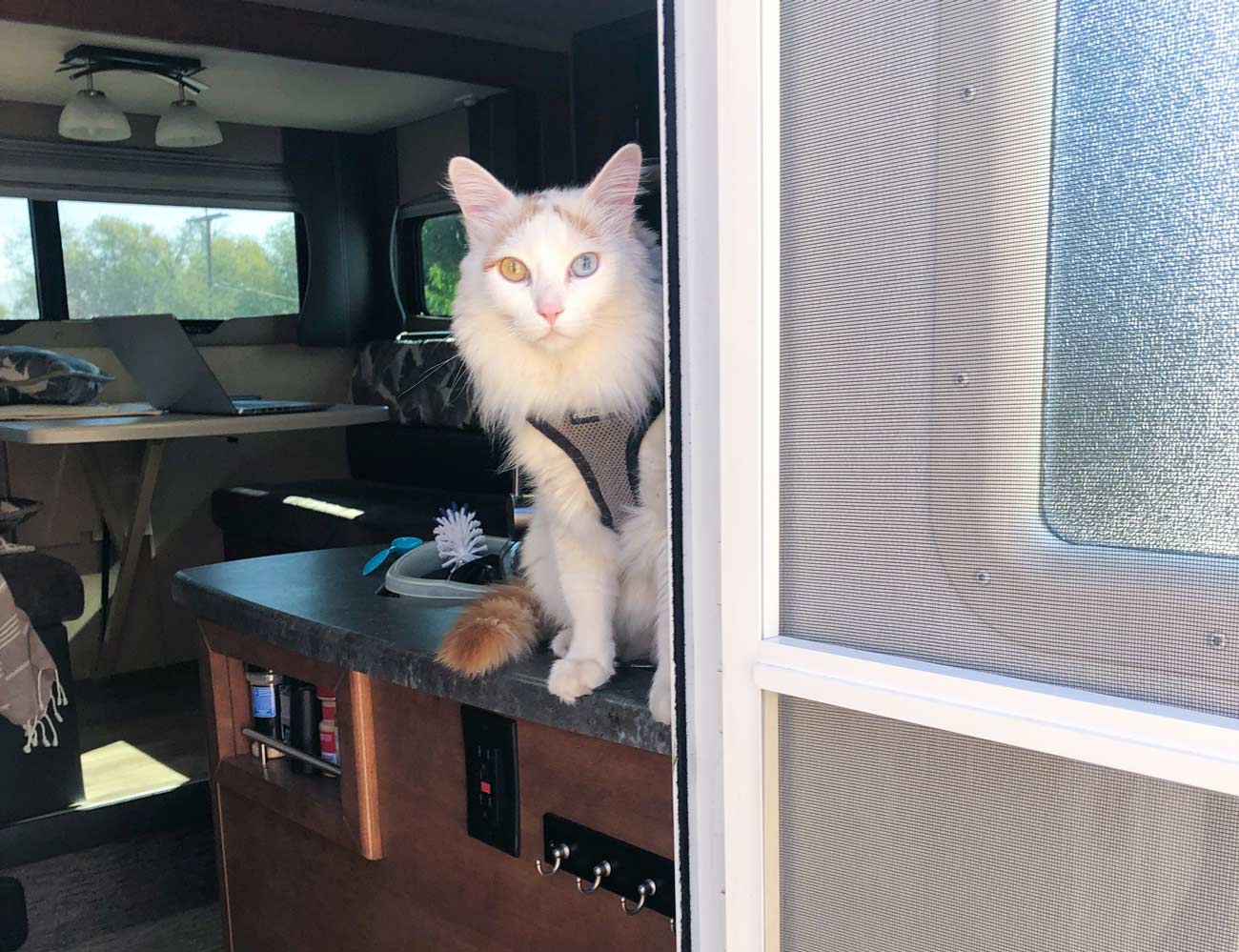
Here are a few things you can do to mitigate some of these issues and prevent your cats from escaping.
- Always ensure windows in the RV are closed, and doors are shut. If your savvy cat learns to open a screen door, purchase an add-on locking feature.
- Ensure everyone using the RV is aware of the cat when they go in and out.
- Create a routine for when your cat can go outside and explore. If your cats know what to expect and you follow a schedule, they are less likely to make a run for it when it’s not ‘outside time.’
Most importantly, if you have a cat prone to escaping, strongly consider a tracker so when they do escape, you’re not in a panic to find them. Our cat wears a harness with a tracker every day.
Read more in the following sections about ensuring your cat has time outside and using tracking devices on your cat.
Exploring Outside with Your Cat
Outside time at your campsite can be exciting for many RV travel cats. It’s a great way to give your kitty plenty of exercise and stimulation so they don’t get bored or start exhibiting undesirable behaviors around bedtime!
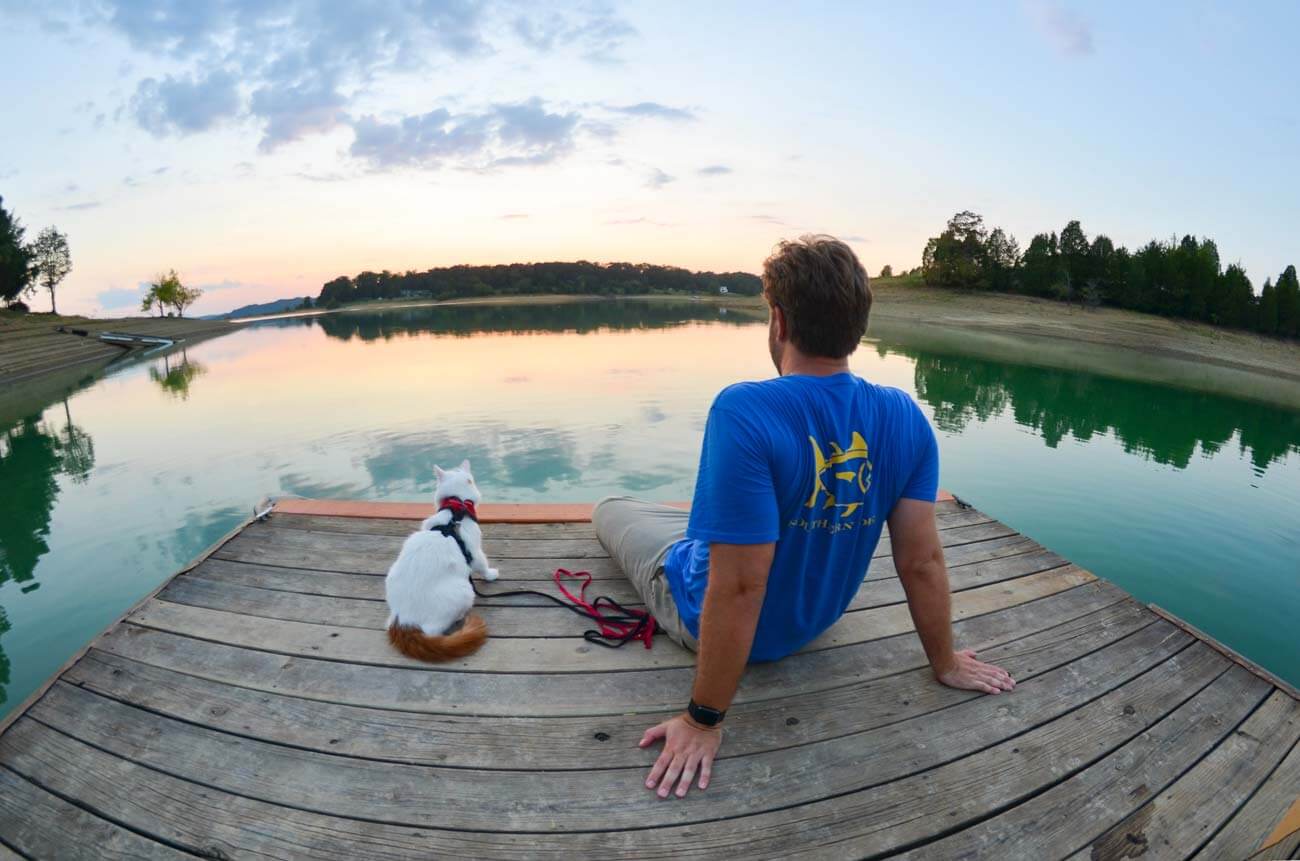
Before you rush out to start taking on the trails with your cat, here are a few things to be aware of.
- TAKE NOTE OF YOUR REGION AND SURROUNDINGS. In the southwest, you will likely come across campgrounds with ‘Goatheads’. These can get stuck in your cat’s paws and be very comfortable. You will likely experience woodsy campgrounds with a long tick season in the southeast.
- BE AWARE OF LOCAL WILDLIFE. You also want to be aware of snakes, scorpions, and other creatures native to the area.
If you can harness-train your cat, it will make your life easier for outdoor adventures. In addition to walks, we have also found tying our cat up with a long lead to an RV door handle or picnic bench works if he wants to chill outside after a walk. Keep a close eye on your pet if you decide to do this since more energic cats might wander about and get tangled.

Since harness training doesn’t always work, an RV cat enclosure or cat tent is another popular way to get your cat outside.
These enclosures are a great way to let your cat enjoy all the benefits of time outside while ensuring their safety.
RV Cat Litter Box
One of the biggest questions when traveling with cats in an RV is – what do you do with the litter box?
A kitty litter box can quickly become a big problem in a small space. Below we’ll talk about some things to be aware of when selecting a spot for your cat to do his business.
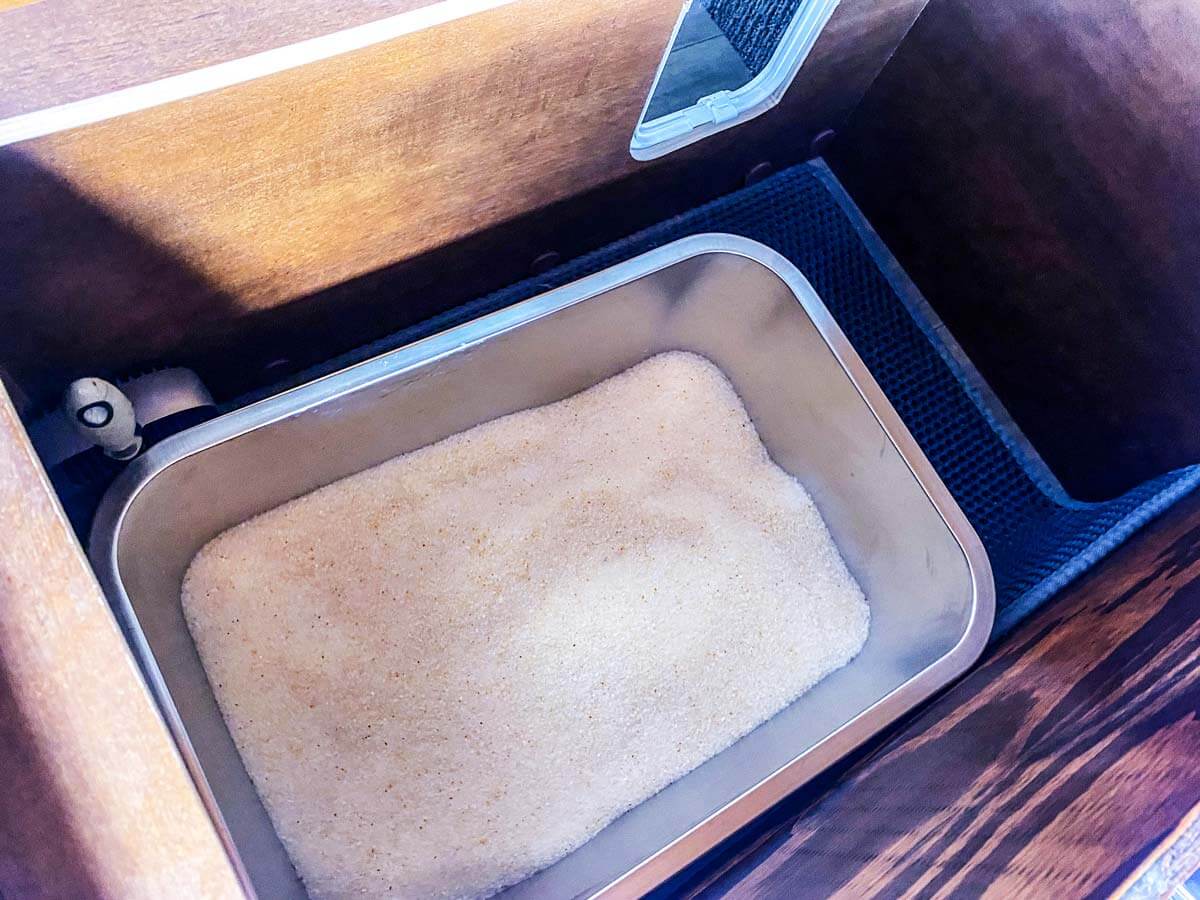
RV Litter Box: Where to Put it?
If you are RVing with multiple cats, you may want a space big enough for numerous litter boxes or more than one space for a litter box. Keep in mind places to put the litter box while shopping for your RV, but even if you already have your RV, you should be able to find a good spot for the litter box.
Here are a few ideas for places to put the litter box.
- IN THE SHOWER. The shower is probably the easiest solution and one we took advantage of in our class C. The downside is you will have to move the litter box each time you shower. I recommend a large cat mat to keep litter from going down the drain.
- BATHROOM CABINET. This area is another good option if you remove the cabinet doors or cut a hole for a cat door on the side of the cabinet. The downside is you will lose bathroom storage space.
- CAT LITTER CABINET. You can add a cat litter box cabinet such as this to any area in the RV. You might need to make modifications, such as removing a chair, table, or the end of a dinette, but it could be a good solution.
- BASEMENT AREA. The basement storage areas of motorhomes and large towables are often good spots for a litter box. Cut an access hole from the inside of your RV to the basement storage to make this work. The benefits are it will keep the mess and smell out of the RV.
- UNDER-BED STORAGE. We utilize this space in our current travel trailer. We sectioned off an area under the bed and cut a hole to install a cat door so our cat could easily access the litter box. (See photo above.) A benefit of this setup is it’s easier to contain stray cat litter. A downside is having to get under the bed to scoop the box. (It seems like my husband is always on the bed when I need to scoop!)
NOTE: Some cats might like doing their business outdoors. Once our indoor cat started exploring outside, we discovered his preference for doing this business in the dirt. This helps with litter usage, but you must remember to bring a bag when walking your kitty.
What Kind of Litter Box Do You Need?
There are pros and cons to different types of litter boxes in an RV. Below are a few options for cat boxes and their benefits.
- TOP ENTRY LITTER BOX. This type of litter box can be great for containing litter that can potentially get scattered around your RV. This box is also easy to move around without spilling anything. This makes top entry boxes a good option for kitty boxes that are kept in the RV shower. These boxes won’t work in storage areas with height restrictions – under the bed, for example.
- COVERED LITTER BOXES. Covered boxes with an opening on the side are a good option for under-the-stairs or basement storage, where a cat door can lead directly into the opening of the litter box. These are usually bulky boxes, so you need space for these to work.
- OPEN LITTER BOXES. These are some of the most flexible litter boxes since they can usually fit in a small space and don’t require much vertical space. Areas such as cabinets, under-the-bed storage, and custom cat cabinets work well with open litter boxes.
You might want to invest in a cat litter mat to keep as much litter as possible from scattering across the RV.
PRO TIP: Stainless steel litter boxes are long-lasting and don’t absorb smells like plastic boxes.
Best Cat Litter for RV
The best cat litter for your RV is usually the one that currently makes your cat happy. However, there are a few concerns regarding cat litter choices in an RV.
- Litter tracking in a small space
- Litter box smell in a small space
- Disposal of litter
Although there are some excellent clumping clay litters on the market, these litters tend to create the most considerable amount of waste.
If you are doing a lot of boondocking, trash is a more significant concern, and you may want to consider pellet or crystal litter types. The Breeze Litter System is popular amongst RVers.
Keeping a Clean Litter Box
You might prefer to scoop the litter box more often than at home in your small RV space. However, getting rid of kitty waste isn’t always easy on the road.
The Litter Genie is an excellent option for storing cat waste until there’s a good opportunity to throw it away. Think diaper genie but for cats! The Litter Genie will hold about 14 days of used litter.
Suggested Cat Litter Products for RVers
Durable and long-lasting litter products for RVing with cats.
Gear for RVing with a Cat
If you are going RVing with a cat, you will no doubt need some specific gear to make your cat’s RV life the most enjoyable. In addition to the usual supplies (food, water, litter box), you’ll need some special gear to keep your kitty safe and comfortable.
A harness and leash are a great help when walking and exploring new areas.

You also might need a carrier for times when you’ll be driving. And don’t forget the toys! Cats love to play, and a few familiar toys can help reduce stress while on the road.
By being prepared, you can ensure that you and your cat have a fun and safe adventure.
Cat Harness
Depending on the size of your RV and your cat’s demeanor, it might not be necessary to harness-train your cat.
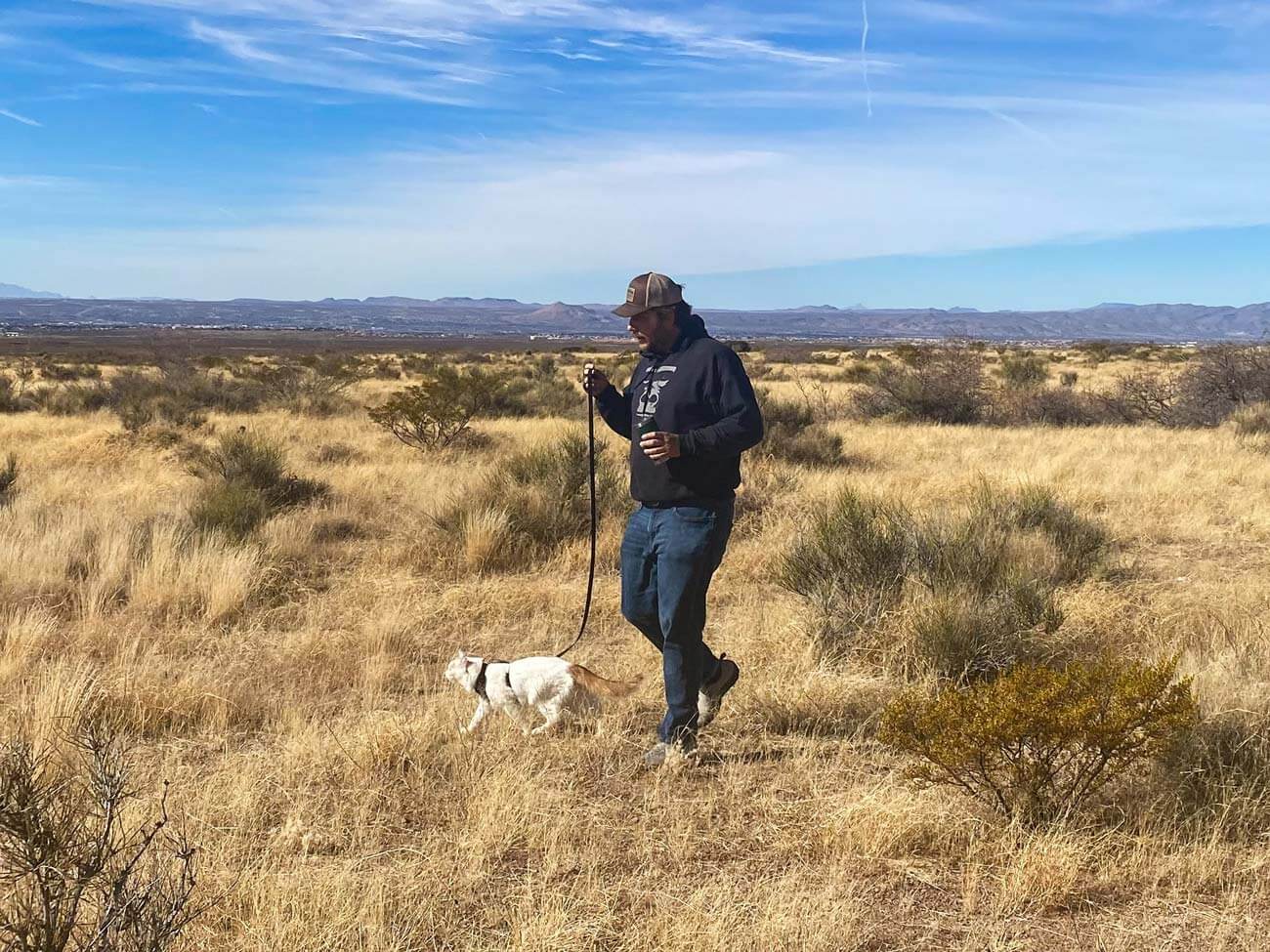
If you have an indoor cat, they may be happy as pie staying in the RV. For energetic felines, the less space in your RV, the more necessary it will be for your cat to be able to exercise outside.
Although cat enclosures can help with outside time, harness training your cat will make going outside much easier.
Here are a couple of cat harnesses we recommend that allow you to adjust both the body and neck straps.
PRO TIP: For more info on harness training your cat, check out this post from adventurecats.org.
Cat Tracking Devices
Tracking devices are a great way to keep tabs on your cat while RVing. Both for safety and peace of mind while traveling.
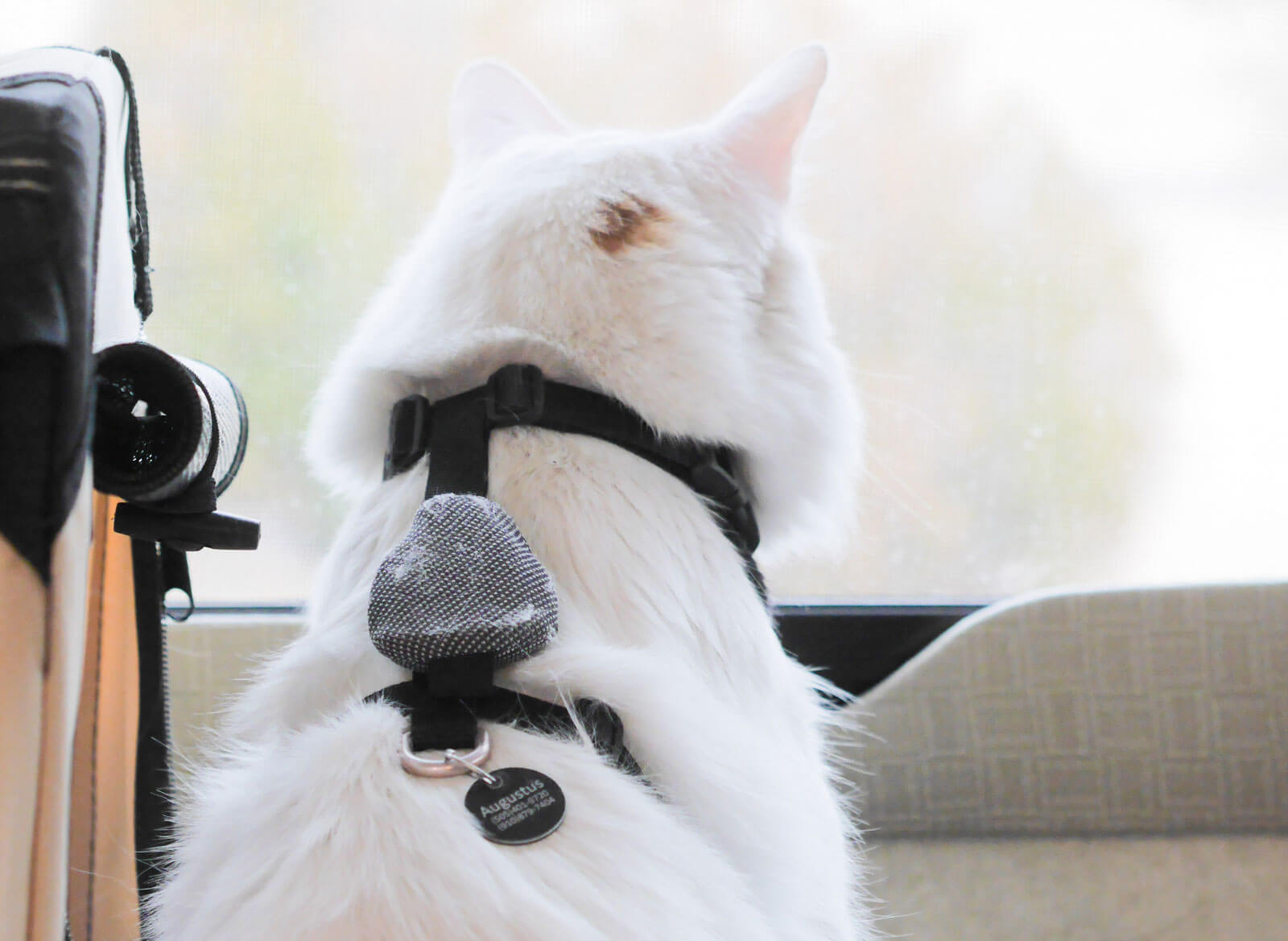
Many trackers can be large due to the need for a long-lasting battery, so it can be hard to find a tracker that isn’t bulky and heavy, especially for smaller cats. Teaching your cat to wear a harness makes it easy to attach a tracker on their back rather than hanging a heavy tracker around their neck.
One of the pros of both trackers listed below is they are reasonably lightweight.
Tile Pro (Bluetooth Only)
The Tile Pro is a great budget option for tracking your cat. It is Bluetooth only, so you must be within 400 feet of your cat. But unless your cat wanders freely, this is most likely all you will need.
The Tile Pro never needs charging, making it a ‘no fuss’ option for tracking your cat. You can check out the Tile Pro on Amazon here.
Jiobit (Bluetooth, Wifi, GPS)
The Jiobit is for cats that are slightly more prone to wandering or escaping the RV. We graduated our cat to the Jiobit when he started going out on his own when we moochdock at our parents’ house.
This device gives you a wide range of tracking abilities and accuracy.
- You can set a perimeter in the device’s app or use Wi-Fi as the perimeter. A notification can be sent if the device is no longer attached to a designated Wi-Fi signal or if the cat leaves the perimeter.
- The GPS tracking is a plus if your cat wanders out of Bluetooth and Wi-Fi range.
This device requires regular charging and a monthly subscription. You can view the Jiobit on Amazon here.
|
Primary Rating:
4.4
|
Primary Rating:
3.8
|
|
N/A
|
N/A
|
|
Description: The Tile Pro is a Bluetooth tracker that is intended to track things like your keys, but we found it was an affordable option that worked well to track our cat. We attached it to the D-ring on the cat’s harness. The Pro version has a 400-foot range. |
Description: The Jiobit is a tracking device designed to track pets, children, and/or seniors. This device uses Bluetooth, Wifi, and a required cellular data plan to track the person or pet the most accurately while conserving battery life. |
|
Pros: |
Pros: |
|
Pros:
|
Pros:
|
|
Cons: |
Cons: |
|
Cons:
|
Cons:
|
The Tile Pro is a Bluetooth tracker that is intended to track things like your keys, but we found it was an affordable option that worked well to track our cat. We attached it to the D-ring on the cat’s harness. The Pro version has a 400-foot range.
- Inexpensive compared to other trackers
- Small and lightweight compared to most trackers
- Water-resistant
- The battery is easily replaced after months of use
- Within range, you can 'ring' the Tile to locate your cat
- Out of the 400-foot range, there is no tracking
- No directional tracking (you get status updates (‘moderate’ or ‘strong’ signal), but you can’t tell in which direction
The Jiobit is a tracking device designed to track pets, children, and/or seniors. This device uses Bluetooth, Wifi, and a required cellular data plan to track the person or pet the most accurately while conserving battery life.
- Track at any distance with the data connection
- Live tracking mode to view cat’s movement in real-time
- Can alert you when your cat leaves a designated area
- Small size compared to other GPS trackers
- Waterproof
- Requires a monthly data plan
- Needs charging once a week (on average)
- Live tracking mode will drain the battery quickly
- Data plan will not work outside of the U.S.
- Will scratch easily if you don’t purchase the optional cover/sleeve
NOTE: Also, make sure to microchip your cat as a backup. We also attach a pet ID tag to our cat’s harness. This method allows someone to easily find out who your cat belongs to and contact you.
Cat Carriers for RV Traveling
If you are traveling with your cat in a fifth-wheel or travel trailer, you’ll need a carrier or other setup for travel days in the truck or SUV. Some cats ride in vehicles well and don’t need a carrier. However, if your cat is even a little nervous about car rides (like ours), it’s easier to have a comfy carrier that’s a safe space.
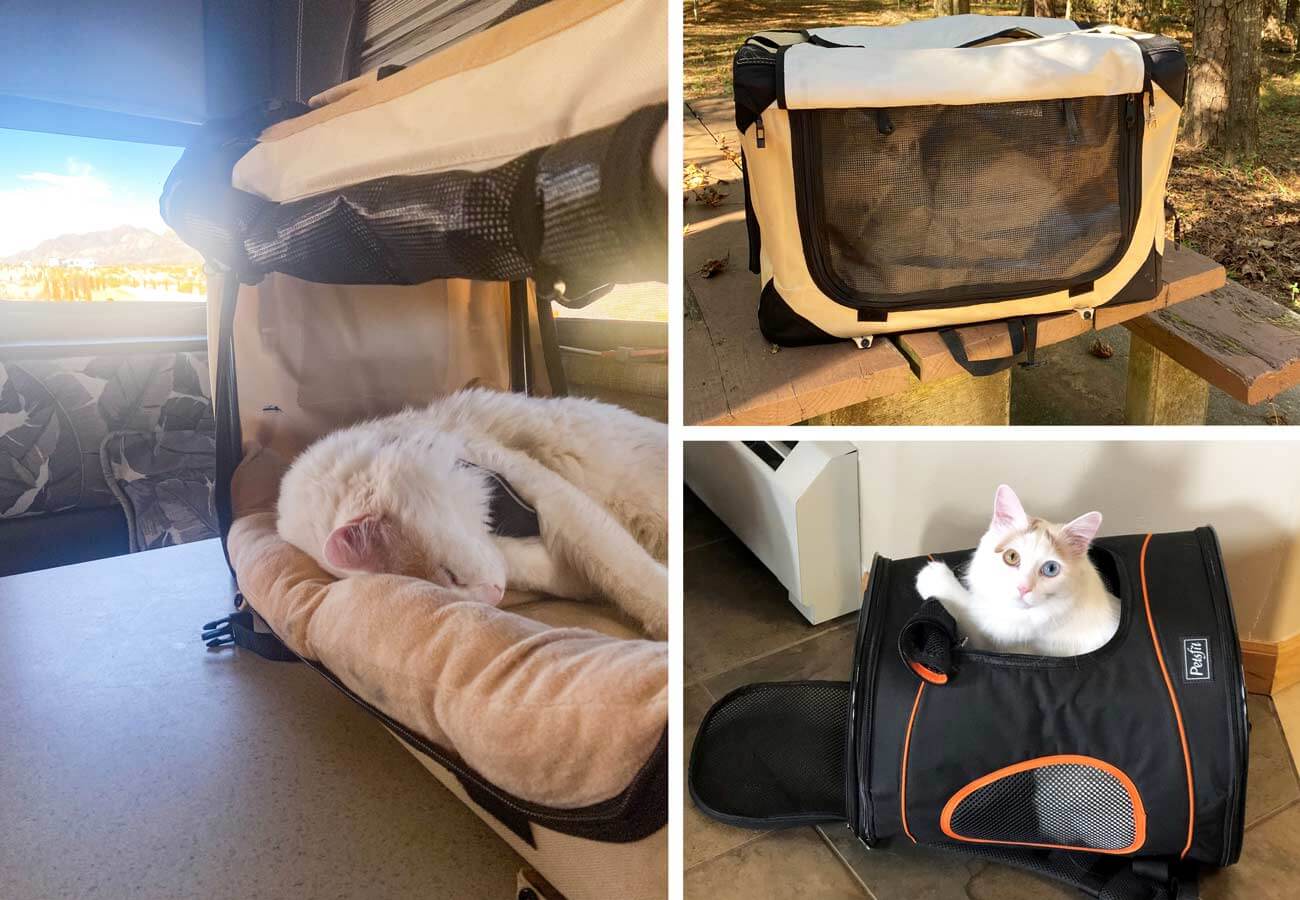
We highly recommend this cat carrier that buckles into the seat. It has mesh zipper flaps on three sides and solid flaps if your cat is calmer without visibility. It is a large carrier with plenty of room to hold two small cats or one large one.
- Three side openings and one top opening (privacy panels on all but front opening)
- Seat belt lock and locking zippers for safety
- Shoulder straps for transporting
NOTE: Although some folks travel with their pets inside the towable RV, I don’t recommend it. Only do this if your cat is adamant about riding there. Be sure to check on them often or have a wireless camera set up on travel days.
Cat Enclosures
Cat enclosures are some of our favorite RV modifications for cats. Although you can purchase a variety of cat enclosures, many RVers are creating their own custom enclosures that attach to their RV and provide a safe and secure space for cats to explore.
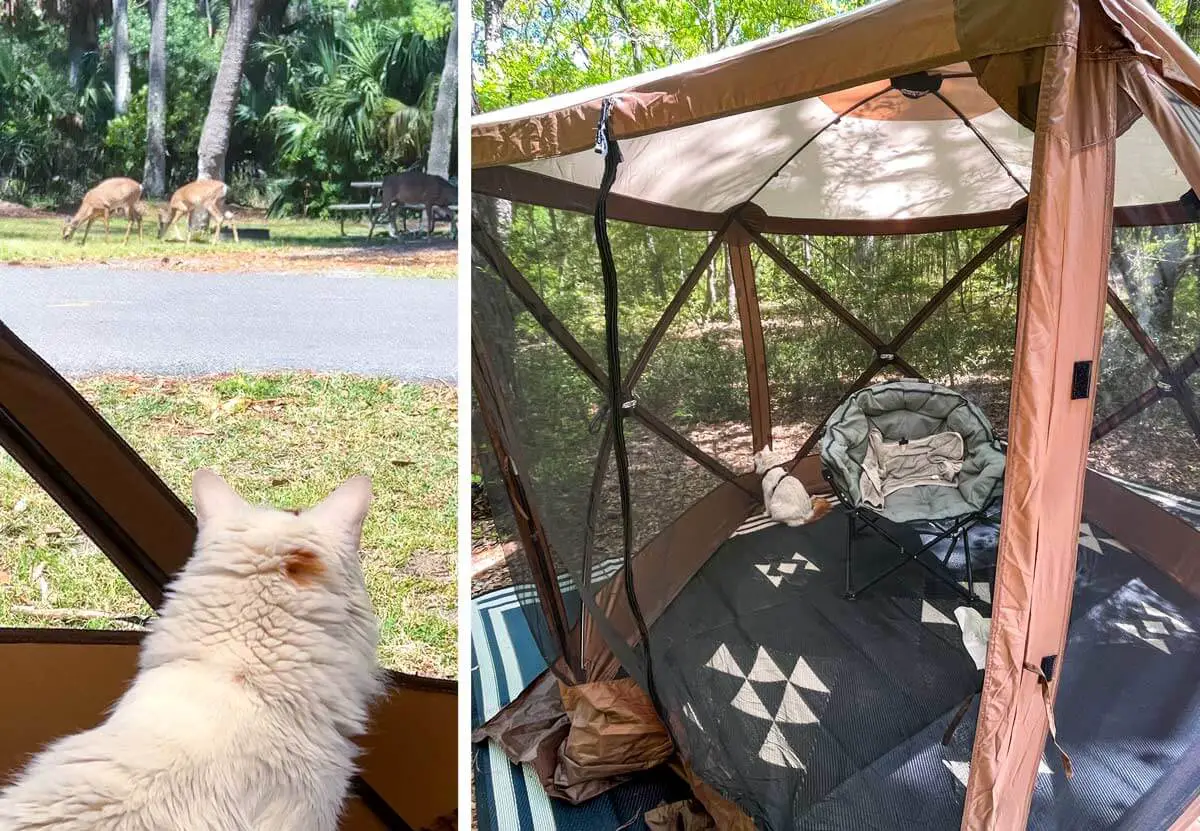
Enclosures typically feature multiple levels, allowing cats to climb and play. Some even have built-in scratching posts and toys, providing hours of entertainment.
Here are a few cat enclosure options.
- For custom cat enclosure ideas, check out this post at tiresandtrails.com
- For a pre-built enclosure, check out this option.
- Cat tents can also be a great option for your cat to get outside. Here are some cat tent options on Amazon.
- If you have a CLAM outdoor tent or other popup gazebo for yourself, you could also use this as an outdoor area for your cat. Be aware that these screen tents are not made for cats, and a determined cat can escape this setup.
Whether looking for a short-term solution for a cross-country trip or a permanent fixture for full-time RVing with cats, a cat enclosure is a great way to give kitties some much-needed fresh air.
Cat Food Storage
If you’re full-time RVing with cats, you may need to store an ample supply of cat food between provisioning trips.
To keep food fresh and rodents and bugs out of your pet’s food, ensure it’s sealed up tight. A storage container such as this can help keep food extra fresh (if your felines are like ours, stale food is not appreciated).
PRO TIP: Store a small amount of cat food somewhere you can easily access it and keep the large supply tucked away in a larger RV storage area.
Keeping Your Cat Cool in an RV
When you RV travel with pets, you not only have to worry about keeping yourself cool in the summer months but keeping your pets cool as well. RVing with a cat is especially challenging since you generally can’t scoop up a cat and take them with you as you would a dog.
It’s essential to think ahead and take steps to keep your cat from overheating, especially if you’ll be boondocking without access to AC.
Here are some options for keeping your cat cool.
- Open windows on each side of your RV to create a cross breeze while away from the campsite.
- Run a DC-powered (or battery-powered) fan to keep air moving in the RV while you are away and avoid draining your batteries.
- Cats are notoriously bad at staying hydrated, so make sure there is always plenty of fresh water available, and consider feeding your cat wet food if it’s particularly hot outside.
- Invest in a temperature monitoring system for when you are away from the RV. Below are a few good options that will allow you to monitor the temperature in the RV.
The Govee option works with a Wifi connection in the RV (suggested if you have a router/modem installed).
The Waggle option requires a monthly subscription since it runs on a Verizon wireless plan.
Emergency Vet Care
RVing with a cat can be a great way to travel with your furry friend, but it’s essential to be prepared for anything.

Talk to your vet about your cat’s health and safety before hitting the road. Make sure your cat is up-to-date on all their vaccinations, and ask about any special travel considerations.
For example, some cats may need a different vaccine if exposed to other regions. Ticks, heartworms, and feline leukemia might also be a more significant concern at other RV destinations. Remember to talk to your vet about a first-aid kit for your cat in the RV.
PRO TIP: While traveling, be sure you know the phone number and address of the nearest emergency vet care facility in case your cat needs medical attention while you’re on the road. Store cat medical records electronically on your phone, so when you need them they won’t be hard to access.
More Resources for RVing with Cats
Below are a few resources we recommend for even more information about RVing and traveling full-time with a cat.

- RV TRAVELING WITH CATS FACEBOOK GROUP provides helpful information from part-time and full-time RVers traveling with their cats. In this group, you can search for previously asked questions or ask questions of your own.
- ADVENTURECATS.ORG or the book Adventure Cats: Living Nine Lives to the Fullest – this organization is one of our favorite resources for adventuring with your cat. Check out their article RVing with Cats: What You Need to Know. They also have a lot of great info on harness training your cat.
Adventure Cat Instagram Accounts
Some of our favorite Instagram accounts feature people traveling or adventuring with cats.
- @wildinthehills is a couple doing full-time van life with their three cats.
- @fisherthemainecoon is an awesome Florida cat who regularly goes boating, RVing, on walks, and even tubing with his humans.
- @greatgramsofgary is a cat in the Canadian Rockies who is always up for an outdoor adventure and is famous for going skiing with his human!
READ NEXT: If you explore by land and water, you might also like our post, Cat on a Boat 101.
Going RVing with a Cat
RV camping with cats can be a great way to explore and bond with your furry travel mates.
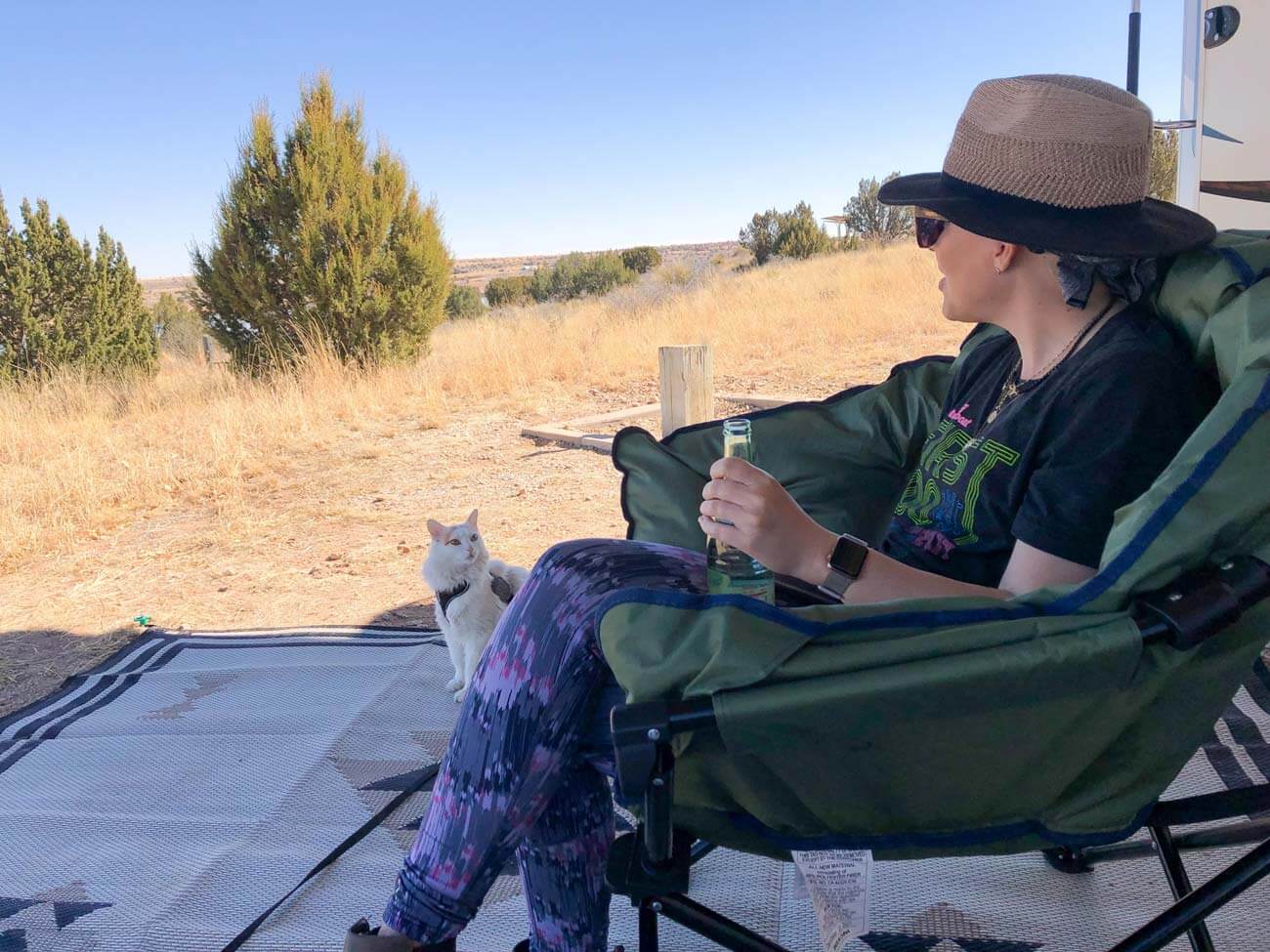
Learning how to travel with a cat is important, so remember to take your time and go at your cat’s speed. As a cat owner, I’m sure you know cats tend to do what they want when they want – so let them set the pace.
By following these tips, you can ensure that you and your cat have a fun and safe RVing experience!
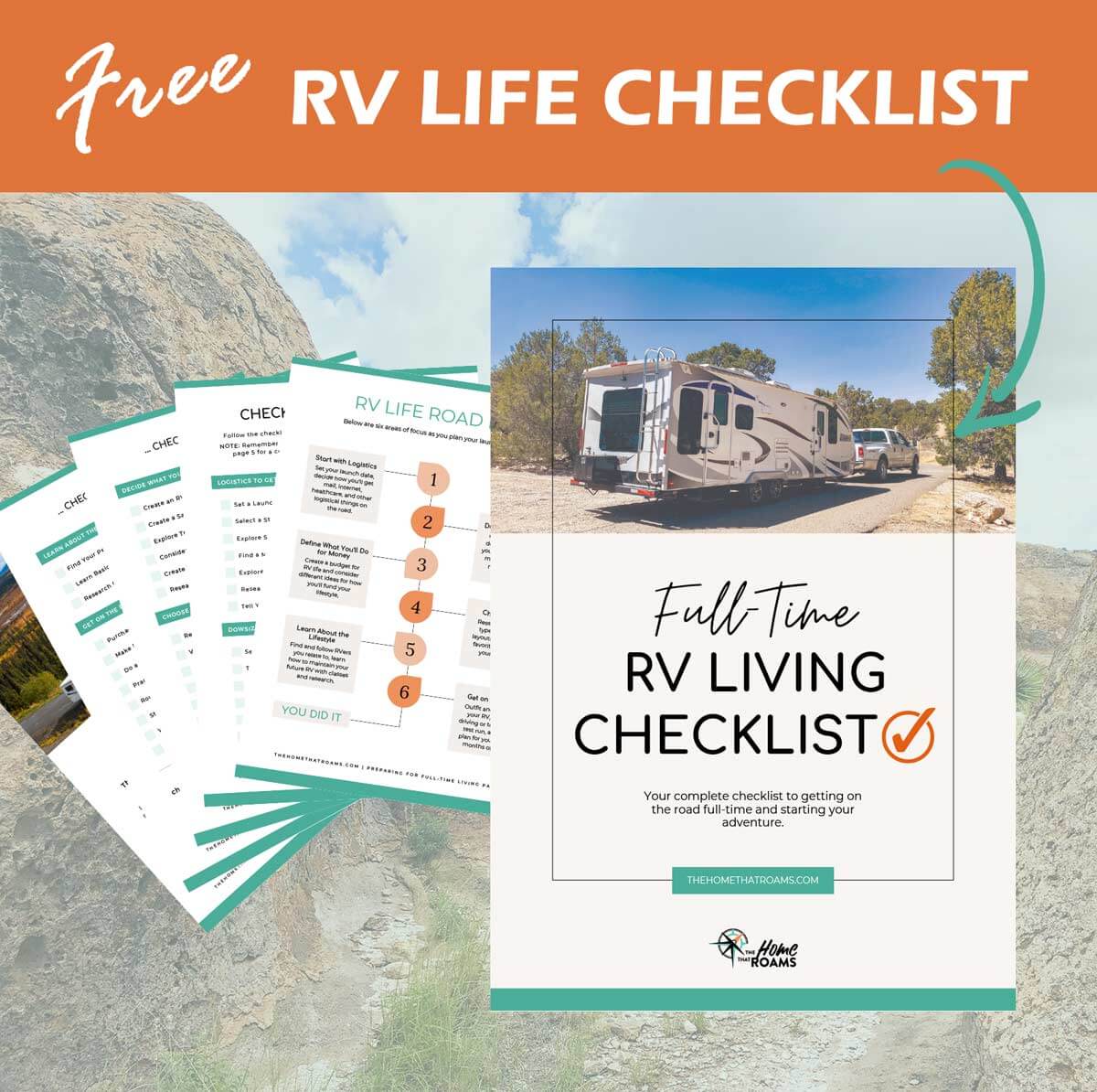
Your Guide to Launching RV Life
Road Map & Checklist – Start Now!
Unsubscribe at any time. View our privacy policy.
Want more beginner tips on RVing and how to get started?
Check out our RV gear lists, info on how to prepare for RV living, the pros and cons of the lifestyle, and more in our guide.
Like this post? Save it on Pinterest for later.
